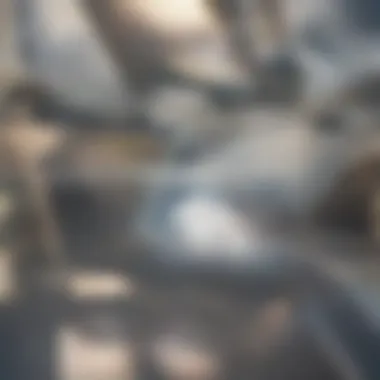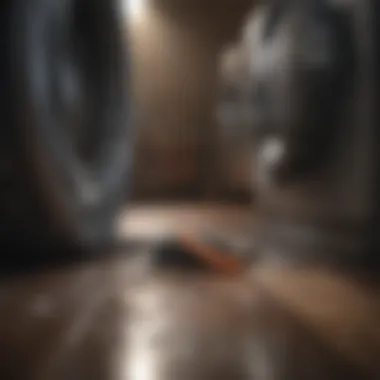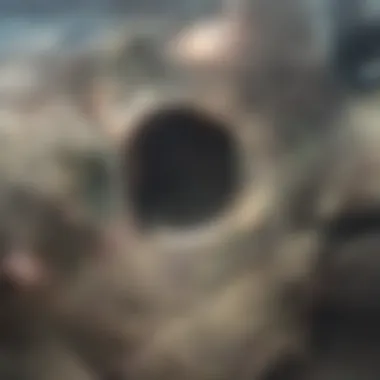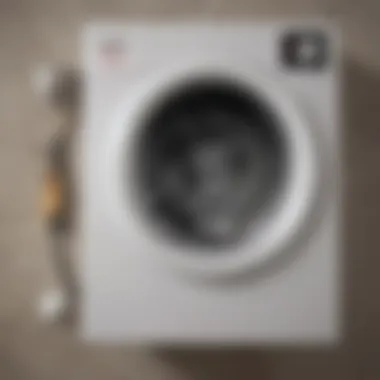A Comprehensive Guide to Cleaning Your Wall Dryer Vent


Intro
Cleaning your dryer vent is a task that many homeowners overlook. Yet, it is vital for the safety and efficiency of your home. Wall dryer vents are especially prone to blockages due to their structure and installation. Regular maintenance ensures that your dryer operates efficiently, reducing energy consumption and minimizing fire hazards. In this article, we will explore the step-by-step process of cleaning your wall dryer vent, the tools needed, safety precautions to consider, and signs to watch for that indicate a blockage. If you are aiming to keep your home safe and maintain the efficiency of your dryer, understanding these aspects is essential.
Importance of Cleaning Your Wall Dryer Vent
Neglecting to clean a wall dryer vent can lead to serious complications. Here are some key points:
- Fire Hazards: Lint accumulation poses a significant fire risk. According to the National Fire Protection Association, failure to clean dryer vents is one of the leading causes of home dryer fires.
- Energy Efficiency: A blocked vent forces the dryer to work harder, leading to increased energy consumption. This not only results in higher utility bills but can also shorten the lifespan of your appliance.
- Drying Time: If your clothes take longer to dry, this can indicate a blockage. Situations like this decrease your efficiency and can lead to frustration.
Tools Required for the Cleaning Process
To effectively clean your wall dryer vent, some specific tools are necessary. Here’s a concise list:
- A vacuum cleaner with a hose attachment
- A screwdriver
- A dryer vent cleaning brush
- A flashlight
- Safety goggles and gloves
Having the right tools at hand will make the process smooth and ensure thorough cleaning.
Step-by-Step Instructions
Cleaning a wall dryer vent involves several clear steps:
- Safety First: Disconnect your dryer from the power supply. This is crucial for your safety during the cleaning process.
- Accessing the Vent: Use a screwdriver to remove any vent covers. Note how it is attached for reassembly later.
- Visual Inspection: Use a flashlight to check for any visible lint build-up or blockage.
- Using the Brush: Insert the dryer vent cleaning brush into the vent. Rotate the brush back and forth while pulling it out gently. This helps in dislodging any lint stuck in the ductwork.
- Vacuuming: After cleaning, use the vacuum to remove any debris that may have been dislodged during the brushing process.
- Reassemble the Vent: Replace any covers or fittings you had removed and ensure everything is secure.
- Reconnect the Dryer: Plug back in your dryer and conduct a quick test run to ensure airflow is normal.
"Regular cleaning of your dryer vent is not just a recommendation, it's a necessity for a safe home."
Signs of Blockage
It is crucial to be vigilant for signs that indicate your wall dryer vent may be blocked. Some common indicators include:
- Clothes taking longer than usual to dry
- A burning smell coming from the dryer
- The vent hood flap not opening when the dryer is on
- Increased humidity in the laundry room
Identifying these signs early can prevent more serious issues later.
Closure
Cleaning your wall dryer vent is an essential home maintenance task that ensures safety and efficiency. By understanding the importance of this process and applying the step-by-step instructions provided, you can manage this task effectively. Regularly inspecting and cleaning your vent is a proactive measure that should not be overlooked.
Preface to Dryer Vent Maintenance
The maintenance of dryer vents is often overlooked in home care routines. However, it serves as a critical aspect of household safety and efficiency. Many homeowners do not realize that a clean dryer vent is essential for the effective operation of their drying appliances. This section aims to illuminate the importance of dryer vent maintenance and highlight its numerous benefits.
Why Cleaning Your Dryer Vent Matters
Cleaning your dryer vent is not merely a task that can be postponed. There are several reasons it should be a priority. First and foremost, a clean vent improves the efficiency of your dryer. Lint and debris accumulate in the vent over time, restricting airflow. This can lead to longer drying times, resulting in increased energy consumption. Addressing this issue can enhance dryer performance and save on electricity bills.
Moreover, a clear dryer vent greatly reduces the risk of house fires. According to the National Fire Protection Association, failure to clean dryer vents is a leading cause of dryer-related fires. When lint builds up, the risk of ignition increases significantly. By keeping the vent clear, you reduce this risk and enhance your home’s safety.
Additionally, regular maintenance extends the life of the dryer. A machine that struggles to expel hot air can overheat, leading to premature wear and potential breakdowns. Routine cleaning helps in maintaining overall functionality, reducing repair costs in the long term.
Understanding the Risks of Neglecting Vent Cleaning
Neglecting dryer vent cleaning presents a series of substantial risks. The most immediate concern is fire hazard. As previously mentioned, lint is highly flammable. A small spark can ignite the accumulated lint, leading to potentially catastrophic consequences.
Furthermore, clogged vents pose health risks. They can lead to excess moisture being trapped in your laundry area, fostering the growth of mold and mildew. This situation may result in respiratory issues for those with allergies or asthma. In particular, damp spaces can encourage pests, creating additional problems.
Lastly, ignoring dryer vent maintenance may result in costly repairs down the line. If a dryer overheats due to obstruction, components can fail. This often leads to expensive repairs or the need for a replacement appliance.


A proactive approach to cleaning your dryer vent not only saves time and money but also safeguards your home. Keeping these factors in mind can motivate one to take action and prioritize this essential task.
Signs That Your Dryer Vent Needs Cleaning
Recognizing the signs that your dryer vent requires cleaning is crucial for maintaining an efficient and safe drying environment. Ignoring these signals can lead to serious problems, including increased energy costs and potential fire hazards. By staying attuned to these indicators, homeowners can take proactive measures to address issues before they escalate, ensuring their appliances work effectively and safely.
Increased Drying Times
One of the most noticeable signs that your dryer vent needs cleaning is an increase in drying times. If clothes consistently come out damp even after a full cycle, it may suggest that lint buildup is obstructing the airflow. This not only affects drying efficiency but also puts additional strain on the dryer itself, potentially shortening its lifespan.
Checking the time it takes to dry a load can offer insights. As a rule of thumb, if drying times exceed normal expectations, it's time to investigate.
Burning Smells During Operation
A burning smell while your dryer is running is a serious warning sign. This odor often indicates overheating, which can occur when lint accumulates in the vent and restricts airflow. When the dryer overheats, it risks not just damage to the appliance but also a fire hazard.
If you notice any unusual smells emanating from your dryer, it’s essential to turn it off immediately and evaluate the situation. You should contact a professional service if the issue persists after checking for lint obstructions.
Fluffy Lint Around the Dryer
The presence of fluffy lint around your dryer is a clear indication that the vent is clogged. While some lint is expected during normal operation, an excessive amount around the appliance suggests that the dryer may not be venting properly. This lint can easily ignite and poses an increased fire risk. Regularly inspecting the area for lint buildup can help mitigate this concern and prompt cleaning as necessary.
Hot Dryer Exterior
If the exterior of your dryer feels unusually hot during operation, it can be an alarming sign. Excess heat usually indicates that the dryer is working harder to circulate air since the vent is likely blocked. This can lead not just to inefficient drying but also to premature appliance failure.
Monitoring the temperature of your dryer can provide valuable feedback about its performance and venting issues. If you find the surface too hot to touch, it's prudent to check the venting and clean it right away.
Regular inspection and cleaning of your dryer vent can enhance appliance efficiency, improve safety, and reduce energy costs.
Preparing for the Cleaning Process
Preparing for the cleaning process is essential for both efficiency and safety. Taking the time to gather necessary tools and establish safety protocols can mitigate risks while ensuring that the task is performed correctly. Proper preparation not only streamlines the cleaning procedure but also enhances the overall effectiveness of your efforts in maintaining the dryer vent.
Notably, organizing tools before beginning is crucial. It reduces interruptions and minimizes the chances of losing important items during the cleaning process. Furthermore, a well-planned approach enables one to focus entirely on the end goal—cleaning the dryer vent—without unnecessary distractions. It is worth remembering that the outcome will significantly depend on the preparation done prior.
Gathering Necessary Tools and Materials
Before diving into the cleaning process, you must gather the right tools. This will save you time and ensure that you have everything needed within reach. Some essential tools include:
- Vacuum Cleaner: Preferably a high-suction vacuum that has a hose attachment. This is key to removing lint buildup inside the vent.
- Dryer Vent Cleaning Kit: These kits usually come with flexible brushes designed to navigate through duct curves and bends.
- Screwdriver: You may need this for removing the vent cap or disconnecting the dryer from the wall.
- Cloth or Mop: Useful for wiping any surfaces that may need cleaning after dust and debris are removed.
- Safety Goggles and Mask: Protect your eyes and lungs from dust and lint particles that could become airborne during cleaning.
Having each of these tools at hand is critical. They maximize efficiency and foster a smoother cleaning process, preventing potential hazards that could arise from missing items.
Ensuring Safety Precautions are in Place
Before starting the actual cleaning, establishing safety precautions is paramount. First, ensure that the dryer is completely disconnected from the power source. This is non-negotiable. Removing the plug from the wall outlet eliminates the risk of electric shock.
Next, take a moment to inspect the area around the dryer and the vent for any hazards. Ensure there are no flammable items nearby. Clear away any clutter that might obstruct the cleaning process. Finally, wearing safety goggles and a mask protects against the inhalation of dust and lint particles. This step is often overlooked but is vital in maintaining one's health during the cleaning task.
By diligently preparing for the cleaning process, homeowners not only safeguard themselves but also set the stage for a successful long-term maintenance strategy for their wall dryer vent.
Step-by-Step Guide to Cleaning Your Dryer Vent
Cleaning your dryer vent is not merely a homeowner's chore; it is a crucial aspect of home maintenance that ensures safety and efficiency. This section outlines the step-by-step process to clean your wall dryer vent, highlighting each phase's significance. Properly executing each step will reduce fire hazards, improve drying efficiency, and prolong the life of your dryer. The following stages are essential to achieve optimal results in cleaning your dryer vent.
Disconnecting the Dryer
Before initiating the cleaning process, it is vital to disconnect the dryer from the power source. This step is critical for safety as it prevents any accidental start-ups while you are working on the unit. Unplugging the dryer ensures that you can handle the vents without risk of electric shock. Additionally, if your dryer operates with gas, turn off the gas supply to avoid any hazards.


- Locate the power cord of the dryer.
- Pull the dryer away from the wall gently, providing enough space to access the vent.
- Unplug the dryer from the wall outlet. For gas models, ensure the gas valve is turned off.
Accessing the Wall Vent
Once the dryer is disconnected, the next step is to access the wall vent. This might involve removing the vent duct attached to the back of your dryer. Depending on the design of your dryer and vent system, you might need to use a screwdriver to detach screws that hold the duct in place.
- Inspect the connection between the dryer and the vent.
- Loosen and remove any clamps or screws.
- Carefully pull the duct away from the vent, avoiding any bending or damage.
Make sure to note the arrangement of the ducts for easy reassembly later.
Cleaning the Internal Duct
With the duct removed, focus shifts to cleaning the internal duct. This is where lint buildup is most prevalent and can lead to severe obstructions, reducing dryer efficiency. Using a vacuum cleaner with a narrow nozzle, gently insert it into the duct to remove as much lint and debris as possible. A flexible brush can also be employed for stubborn blockages.
- Use a flashlight to check for visible lint buildup inside the duct.
- Employ a vacuum to clear loose lint.
- For deeper cleaning, use a rotating brush specifically designed for vent cleaning.
Cleaning the Exterior Vent Cap
After addressing the internal duct, it is essential to clean the exterior vent cap. This exterior vent is the exit point for heated air and lint from the dryer. Over time, debris and even small animals can obstruct the cap, creating a further hazard.
- Inspect the exterior vent cap for any obstructions or accumulated debris.
- Remove the cap by unscrewing it from the wall.
- Clean the vent cap thoroughly with warm, soapy water. Rinse and dry it before reattaching.
Reconnecting the Dryer
Once the cleaning process is complete, it is time to reconnect the dryer. Ensure that everything is thoroughly dried and free from any debris before proceeding.
- Attach the vent duct back to the dryer.
- Secure any clamps or screws that were removed earlier.
- Carefully push the dryer back into place against the wall, ensuring the vent line is not kinked.
- Finally, plug in the dryer and, for gas models, turn on the gas supply.
Important: Always test the dryer after reconnecting to ensure proper operation. Monitor for any unusual sounds or smells, as these could indicate improper installation or an underlying issue.
Each of these steps is vital not only for ensuring a clean vent but also for enhancing the overall performance of your dryer. Regular maintenance, including thorough cleaning, can significantly reduce fire risks and improve energy efficiency, making it an essential task for any homeowner.
Common Issues Encountered During Cleaning
Cleaning your dryer vent is crucial for home safety and efficiency. However, this process is not without its challenges. Homeowners should be aware of common issues that can arise, as understanding these problems can lead to better decision-making and ultimately a safer home environment. This section will cover two significant challenges: stubborn lint buildup and blockages caused by external forces.
Stubborn Lint Buildup
Lint buildup is perhaps the most frequent issue encountered during dryer vent cleaning. This is not just a minor inconvenience; it poses serious risks including increased fire hazard and reduced dryer efficiency. Lint can accumulate in various parts of the venting system. It can form a dense, clinging mass that obstructs airflow.
Key Considerations for Managing Lint Buildup:
- Frequent Inspections: Regularly inspect your vent for signs of lint accumulation. Being proactive can help mitigate larger problems down the road.
- Use Proper Tools: Invest in quality lint brushes or vacuum attachments designed for vent cleaning. These tools can effectively reach deep into the duct system.
- Seek Professional Help: In cases of significant buildup, consider hiring a professional service. They possess specialized equipment, like rotary brushes, that can clean thoroughly.
"Ignoring lint buildup can lead to dryer failure or, worse, a fire hazard. Proactive measures are essential."
Blocked Vent from External Forces
The second common issue involves blockages caused by external elements such as birds, debris, or even snow. These factors can obstruct the vent's exterior cap, leading to a host of issues. A blocked vent reduces airflow, which in turn increases drying times and puts additional stress on the dryer itself.
Factors Leading to Blocked Vents:
- Natural Elements: Leaves, dirt, and other materials can pile up around the vent cap, especially in outdoor locations. Regular checks and cleaning can prevent this.
- Animal Nesting: Birds and other small animals may find the warmth of the vent appealing and can create nests inside. Installing a proper vent cover can deter this behavior.
- Seasonal Considerations: In colder months, snow and ice can block vents. Ensure that your dryer vent exits away from areas where snow accumulation is common.
Effective resolution of these common issues can keep your dryer operating efficiently, minimize safety risks, and ultimately enhance the longevity of your dryer unit.
Post-Cleaning Maintenance Tips


After thoroughly cleaning your dryer vent, it is essential to focus on maintaining its efficiency and safety. Post-cleaning maintenance tips are critical in ensuring that the benefits of your recent efforts are preserved over time. Regular maintenance not only prolongs the lifespan of your vent system but also avoids future blockages and potential hazards. Establishing consistent routines and monitoring performance can save homeowners time and money in the long run.
Establishing a Regular Cleaning Schedule
Creating a cleaning schedule is an effective way to stay proactive with your dryer vent maintenance. Ideally, you should aim for an internal cleaning at least once a year. However, for those who do regular laundry loads or use the dryer multiple times a week, a semi-annual cleaning is advisable. Here are some key steps to establish a feasible schedule:
- Identify Usage Patterns: Record how often the dryer is used. Higher usage may necessitate more frequent cleanings.
- Set Reminders: Utilize digital calendars or mobile apps to remind you when it is time for the next cleaning.
- Add It to Home Maintenance Checklist: Incorporate dryer vent cleaning into other seasonal maintenance tasks.
By committing to a regular schedule, you can optimize your dryer’s performance and minimize potential hazards from lint buildup.
Monitoring Vent Performance
After completing your cleaning, continuous monitoring of your dryer vent's performance is necessary to ensure ongoing effectiveness. Being attuned to changes in vent performance can help detect issues before they escalate. Pay attention to the following factors:
- Drying Time: If clothes take longer than usual to dry, this could indicate a blockage or buildup of lint.
- Ventilation: Observe if the outside vent flaps open as expected during dryer operation. This ensures proper airflow, which is crucial for efficiency.
- Unusual Noises: Listen for strange sounds, which may indicate an obstruction or mechanical failure within the vent.
Maintaining awareness of these performance indicators can help you address any arising issues swiftly, ensuring that your dryer continues to operate efficiently.
It’s important to remember that a small issue today can lead to larger, costly repairs tomorrow if left unattended.
Professional Cleaning Services: When to Consider Them
Maintaining a clean dryer vent is crucial for both the efficiency of your appliance and the safety of your home. While many homeowners can handle basic cleaning, there are instances when hiring professional services may be essential. In this section, we will explore the specific elements that indicate when professional intervention is necessary, the tangible benefits of such services, and vital considerations to keep in mind.
Identifying Critical Blockages
One of the primary reasons to consider professional cleaning services is the identification of critical blockages in your dryer vent system. Blockages can occur due to excessive lint accumulation or obstructions from external sources like nests or debris. Signs that you may have a blockage include:
- Strange noises during dryer operation
- Impaired airflow at the exterior vent
- Long drying cycles, where clothing remains damp after expected drying time
- Heating elements of the dryer working overtime, causing overheating
If you observe any of these indicators, it is wise to call a professional. They possess the necessary tools, such as specialized lint removal equipment, to effectively remove those stubborn blockages.
Professional services can often identify issues that may not be visible to the average homeowner, ensuring thorough ventilation cleaning and peace of mind.
Evaluating the Benefits of Professional Help
Opting for professional dryer vent cleaning not only resolves existing issues but also contributes to long-term benefits. First, professionals bring expertise and experience to the table, allowing for a thorough assessment of your dryer vent's condition. Some notable benefits include:
- Enhanced Safety: Trained professionals handle potential hazards, reducing risk of fire and related dangers.
- Increased Efficiency: A clean dryer vent enhances airflow, which can improve drying efficiency and reduce energy bills.
- Time-saving: Professionals can complete the task effectively in a fraction of the time it would take an inexperienced homeowner.
- Longer Appliance Life: Regular professional maintenance helps extend the lifespan of the dryer, reducing future replacement costs.
In summary, while routine maintenance can be manageable for a homeowner, recognizing when to seek help is crucial. Utilizing professional services not only alleviates immediate concerns but also contributes to ongoing safety and efficiency in your laundry room.
Culmination: The Importance of Dryer Vent Maintenance
Maintaining your dryer vent is not merely a matter of convenience; it is a critical aspect of home safety and efficiency. Neglecting this maintenance can lead to various problems, including increased drying times and risk of fire hazards. Understanding the implications of proper vent care is beneficial for homeowners who want to ensure that their dryer operates effectively while prioritizing safety.
Recapping the Key Points
Maintaining your dryer vent involves several crucial points that should always be considered:
- Regular Cleaning: It is essential to clean your dryer vent regularly to prevent lint buildup, which can cause inefficiency or even fires.
- Identifying Symptoms: Be observant of your dryer performance. Increased drying times or unusual smells signify that your vent requires immediate attention.
- Safety Considerations: Proper maintenance helps to mitigate fire risks, ensuring that your household remains safe.
- Professional Assistance: Sometimes, it is advisable to seek professional cleaners, especially when there are significant blockages.
- Follow-Up Measures: After cleaning, establishing a regular maintenance schedule enhances long-term efficiency and safety.
These key points encapsulate the importance of understanding and maintaining your dryer vent.
Encouraging Proactive Measures
Encouraging proactive measures in dryer vent maintenance is crucial for long-term performance and safety. Homeowners should integrate these practices into their regular home maintenance routine:
- Set Reminders: Utilize calendars or reminders to schedule regular checks and cleanings.
- Perform Self-Checks: Familiarize yourself with your dryer’s performance and be on the lookout for signs of malfunction.
- Educate Household Members: Inform everyone in your home about possible warning signs that indicate the dryer vent needs attention.
- Research Proper Tools: Invest in appropriate tools or cleaning kits that facilitate the cleaning process.
- Consult Resources: Utilize articles, guides, or videos for reference to ensure a thorough understanding of the cleaning process.
By taking these proactive measures, you not only safeguard your home from potential hazards but also prolong the life and efficiency of your dryer.
"Regular maintenance of your dryer and vent system is key to home safety, enhancing efficiency, and reducing energy costs."
This comprehensive approach to dryer vent maintenance will provide homeowners with the knowledge and motivation needed to take action. Prioritize this task for the well-being and efficiency of your household.





